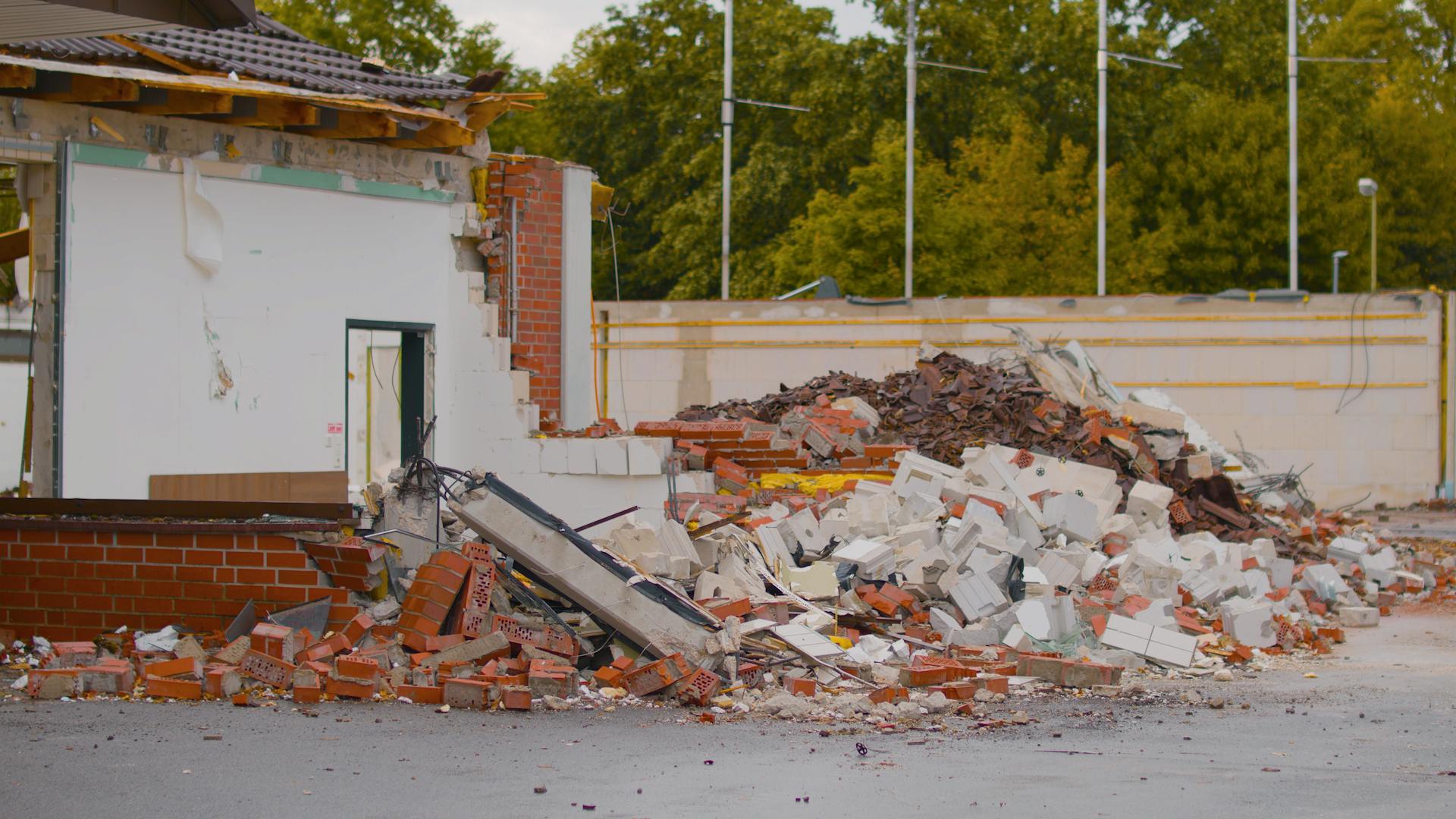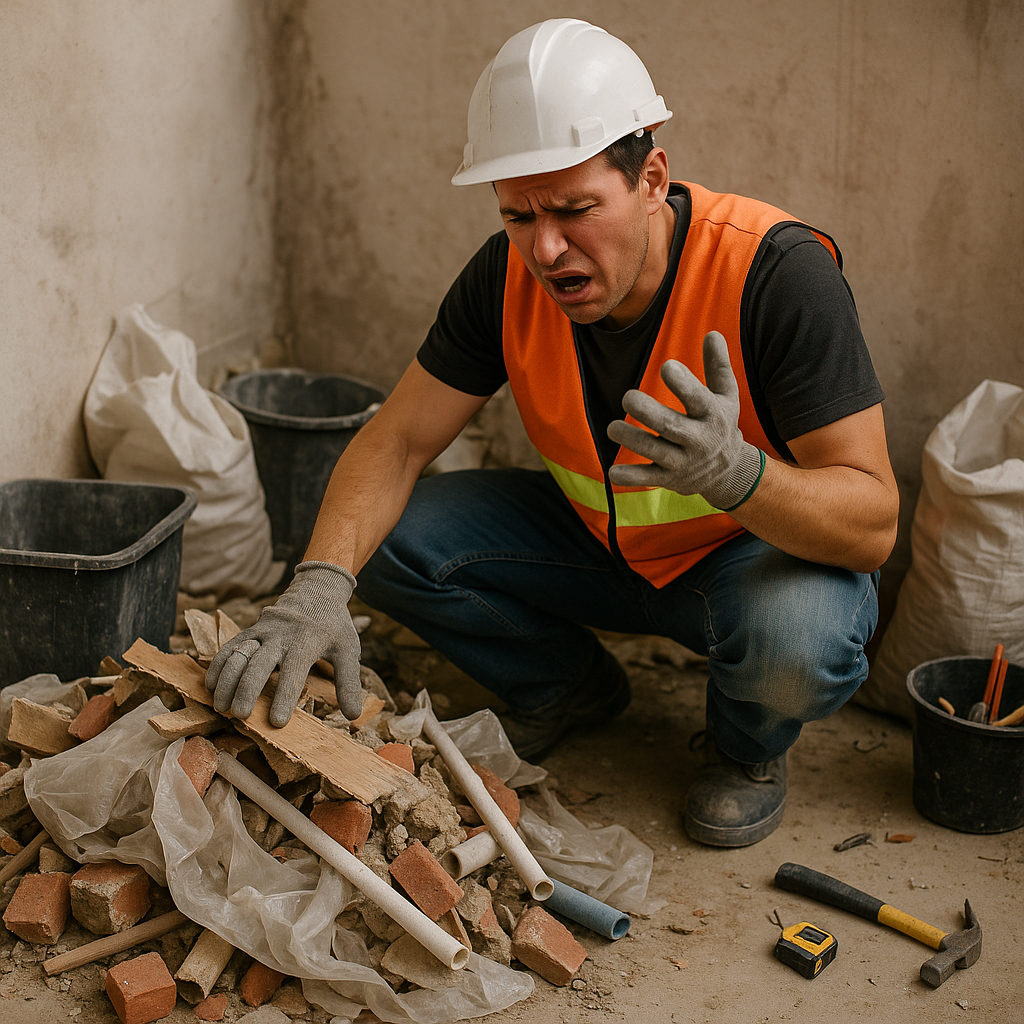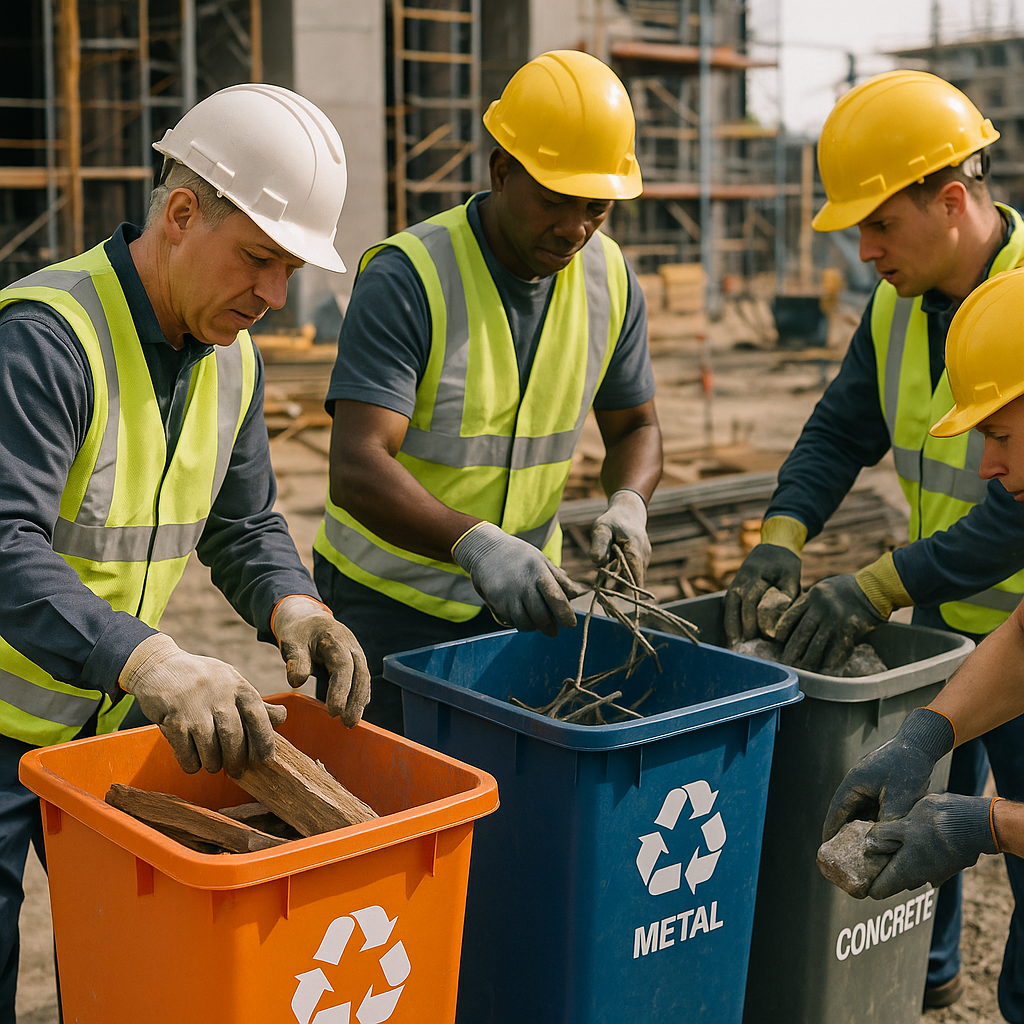5901 Botham Jean Blvd, Dallas, TX 75215
What Is Waste Separation in Construction Projects?
May 15, 2025Construction waste separation is the process of sorting and categorizing different types of waste materials generated at construction sites. This practice involves dividing construction debris into categories such as concrete, wood, metals, plastics, and hazardous materials. The sorted materials can then follow appropriate recycling or disposal pathways.
Every construction project generates substantial amounts of waste. The construction industry accounts for approximately 30% of all waste produced globally. Without proper separation, these materials often end up in landfills, contributing to environmental degradation and increasing project costs.
Waste separation is a key practice in modern construction management. It directly impacts project efficiency, operational costs, and environmental sustainability. By implementing effective waste segregation systems, construction teams can transform what was once considered useless debris into valuable resources.
Why is Waste Separation Important in Construction?

Waste segregation is crucial in managing construction site waste efficiently, cost-effectively, and sustainably. By sorting materials at the source, construction companies can turn waste challenges into opportunities.
Significant Cost Savings
Proper waste separation directly impacts a project’s bottom line. When construction teams produce less waste or separate it effectively, they reduce landfill volume, leading to lower disposal fees, typically based on volume or weight.
Segregating materials like concrete, metal, and wood allows for recycling or reuse, reducing the need for new materials. For instance, recycled concrete can be repurposed as aggregate for new projects, generating substantial savings.
Valuable materials from construction sites can even become revenue streams. Metals like copper and steel can be sold to recyclers for profit, offsetting disposal costs and contributing to a circular economy where materials remain in use longer.
Environmental Sustainability Benefits
The construction industry generates significant waste. Effective segregation significantly reduces the environmental footprint of building projects. Properly sorted materials result in less waste ending up in landfills, decreasing soil and groundwater pollution.
Recycling and reusing construction materials conserve natural resources by reducing the need for raw material extraction and processing, leading to lower energy consumption and fewer greenhouse gas emissions from manufacturing and transporting new materials.
Proper waste management also prevents illegal dumping, which causes significant environmental damage and can lead to regulatory penalties. Effective segregation systems protect ecosystems and promote sustainable development.
Meeting Regulatory Requirements
Construction waste management is increasingly subject to strict regulations, and proper segregation helps companies comply. Failing to meet these regulations can result in hefty fines and legal consequences.
Many municipalities and clients now require construction projects to meet specific recycling goals. Waste segregation is essential to achieve these targets, with some areas mandating a certain percentage of construction waste be diverted from landfills through recycling or reuse.
Compliance with these regulations ensures that construction projects follow environmental standards, leading to safer and more sustainable practices. It also encourages innovation in waste management techniques.
Practical Implementation of Waste Segregation
Effective waste segregation starts with clear systems and proper training. Construction sites should have dedicated areas with marked containers for different waste types, such as concrete, wood, metal, plastic, and hazardous materials.
Worker training is crucial for successful implementation. All site personnel should understand the importance of waste segregation and know how to sort materials properly. Regular waste audits help identify areas for improvement and ensure continued compliance.
Technology can enhance waste segregation efforts. Digital tools help track waste generation and management, and some construction companies use apps to monitor waste streams and identify opportunities for better resource recovery.
How is Waste Separation Implemented on Construction Sites?
Site-separated waste management on construction sites involves strategically placing multiple containers to collect different types of construction and demolition (C&D) waste. This method provides immediate feedback to workers and fosters a responsible atmosphere that supports recycling goals. Workers can observe the sorting process, reinforcing proper disposal practices.
Effective waste separation requires careful planning and organization. Contractors typically deploy separate containers for concrete, bricks, wood, metals, plastics, and other materials. This segregation is crucial for maximizing recycling potential and minimizing landfill contributions.
Practical Waste Separation Strategies
Several strategies enhance waste separation on construction sites, addressing space limitations while maintaining high diversion rates:
- Establish temporary collection bins in each work zone to facilitate convenient disposal for workers.
- Conduct centralized cutting operations to contain wood, metal, and other scraps in one location.
- Schedule frequent waste collection to prevent container overflow and maintain site organization.
- Implement a hybrid recycling approach with separate bins for high-volume materials and one container for mixed recyclables.
- Provide clear signage on each container indicating which materials belong inside.
- Position waste containers near material storage areas to minimize transport distance.
Many construction sites adopt a hybrid recycling approach, combining site-separated and commingled recycling benefits. For example, a project might use individual containers for wood, concrete, and non-recyclable waste. This method balances weight against sorting effort and can reduce hauling fees while maintaining recycling efficiency.
Factors Affecting Waste Separation Systems
Construction managers must consider several factors when developing a waste separation system. The choice of method depends on site-specific conditions:
Space availability is a primary concern, especially in urban areas. When space is limited, hybrid recycling offers an effective compromise. By working in phases, the total number of containers can be reduced while still achieving high recycling rates.
The construction phase also impacts waste separation requirements. During demolition, additional containers and more frequent pickups are necessary to handle the large volume of materials being removed. As projects transition to finishing work, the types of waste change, requiring adjustments to the container mix.
Worker training is essential for successful waste separation. Site superintendents should post guidelines for proper waste handling and ensure all workers understand the importance of following waste separation protocols. Regular inspections of storage areas help reinforce these practices and identify needed improvements.
What Are the Challenges in Construction Waste Separation?

Construction waste separation faces several significant hurdles impacting project efficiency and sustainability goals. Poor management oversight is a primary challenge. When supervisors don’t prioritize waste management, workers lack adequate direction for proper sorting, leading to mixed waste streams that can’t be effectively recycled.
Inadequate communication between project stakeholders is another barrier. When architects, contractors, subcontractors, and waste management teams work in silos, confusion about materials handling arises. Clear protocols should be established before the project begins, with regular reinforcement throughout construction phases.
The absence of a comprehensive waste reduction plan significantly hampers separation efforts. Without strategic guidelines for the entire lifecycle of materials, teams make ad-hoc decisions prioritizing convenience over sustainability. Developing a structured plan that identifies recyclable materials and establishes sorting stations can dramatically improve outcomes.
Material Management Issues
Inaccurate quantity takeoffs lead to excess materials that become waste. When estimators miscalculate, surplus materials accumulate on-site without a purpose. Implementing digital tools for precise material tracking can minimize these errors and reduce unnecessary waste.
Poor quality construction necessitating rework compounds waste separation challenges. When tasks are redone due to quality failures, materials that could have been sorted often get discarded hastily. Enhanced quality control protocols can prevent rework while maintaining proper waste segregation.
Limited space on construction sites makes proper waste separation difficult. Crowded urban projects leave little room for multiple collection containers, forcing contractors to mix waste that should be separated. Strategic site layout planning incorporating dedicated sorting areas can help overcome this spatial constraint.
Operational Barriers
Extended schedules due to low productivity create pressure to cut corners on waste management. When projects fall behind, proper separation often suffers. Setting realistic schedules from the outset can alleviate this pressure and maintain waste separation standards.
Lack of standardized sorting protocols across the industry creates confusion, especially when workers move between job sites. Developing consistent, color-coded systems can help establish habits that transfer between projects. Training programs should emphasize these standards to create workforce-wide familiarity with separation practices.
Regulatory complexity regarding different waste streams presents another challenge. Construction teams struggle to keep pace with evolving requirements for various materials. Designating a compliance specialist to monitor regulations and communicate updates can help navigate this complexity.
Financial and Logistical Challenges
The perceived higher costs of proper waste separation deter many contractors from implementing comprehensive systems. Initial investments in multiple containers and training can seem prohibitive. However, these costs are typically offset by reduced disposal fees and potential revenue from recyclables.
Inadequate training leaves workers uncertain about proper separation procedures. Many construction professionals have never received formal instruction on identifying recyclable materials or contamination issues. Regular training sessions with practical demonstrations can significantly improve compliance.
Logistical challenges in transporting separated waste create additional complications. Finding specialized haulers for different material streams requires more coordination than traditional mixed-waste disposal. Building relationships with recycling facilities and waste management companies before project commencement can streamline this process.
Addressing these challenges requires a multi-faceted approach combining improved project management, better subcontractor oversight, and enhanced quality control measures. By systematically tackling these barriers, construction teams can significantly improve waste separation outcomes while reducing environmental impact and potentially lowering project costs.
How Can Construction Projects Minimize Waste Through Separation?

Effective waste separation begins during the design phase and extends through the construction process. Prioritizing waste minimization from the start can significantly reduce environmental impact and cut costs. Separation focuses on sorting materials properly, facilitating higher rates of reuse and recycling.
Design Phase Strategies
Waste minimization starts with thoughtful design. Coordinating dimensions between structural elements and modular materials minimizes cutting and material offcuts. Using Building Information Modeling (BIM) enables three-dimensional coordination of building systems, reducing on-site errors that generate waste.
Standardizing building elements creates opportunities for repeatability and fewer unique components, reducing waste and streamlining the construction process. Specifications detailing waste diversion requirements and minimum recycled content standards establish clear expectations for all project participants.
Leveraging Prefabrication
Off-site construction methods produce less waste than traditional on-site building. Components manufactured in controlled factory environments result in fewer errors, less rework, and more precise material usage. Prefabricated elements allow waste to be collected and recycled more easily within the manufacturing facility.
Modular construction further reduces waste by creating entire building sections off-site. Major projects using significant prefabrication have reported waste reductions of up to 90% compared to traditional methods, resulting in faster completion and higher quality standards.
Material Selection and Management
Choosing environmentally friendly materials with high recycled content is crucial for waste reduction goals. Materials should be evaluated for performance and end-of-life recyclability. Products certified under programs like Cradle to Cradle ensure materials remain in continuous circular loops.
Just-in-time purchasing reduces surplus materials that often become waste. Specifying takeback programs with suppliers for excess materials creates pathways for unused resources to return to the supply chain. Some manufacturers now offer building systems as services, incentivizing durable, recyclable components.
On-Site Separation Techniques
A comprehensive Construction Waste Management Plan establishes protocols for on-site separation. Dedicated containers for different materials—concrete, metal, wood, drywall, and plastics—enable efficient recycling. Training workers on proper separation techniques ensures compliance with waste management protocols.
Projects have succeeded with “waste sorting stations” strategically positioned on sites. These stations include labeled bins and visual guides showing which materials belong in each container. Regular audits help identify areas for improvement and reinforce best practices.
Reusing Materials On-Site
Before disposing of materials, evaluate opportunities for direct reuse within the project. Excavated soil can be reused for landscaping or site grading. Concrete from demolition can be crushed and used as aggregate for new concrete or base material for roads and pathways.
Dedicated storage areas for reusable materials keep them organized and protected until needed, preventing deterioration. Clear communication about available materials ensures teams know what resources are on hand before ordering new supplies.
Thoughtful design, prefabrication, careful material selection, and rigorous on-site separation create a comprehensive approach to waste minimization. Implementing these strategies can achieve substantial waste reduction while improving efficiency and quality.
Conclusion: The Future of Waste Separation in Construction
Waste separation in construction projects is now a key element of sustainable building practices. By efficiently sorting and managing materials, companies can greatly reduce their environmental impact while supporting the circular economy. The construction industry is undergoing a transformation as waste management becomes a core part of project planning and execution.
As ESG considerations grow in importance, effective waste separation continues to drive innovation and efficiency. AI-powered sorting systems, advanced materials recovery, and digitally managed waste streams are set to change how construction waste is handled. These technologies will enhance resource efficiency, reduce landfill waste, and support the industry’s shift toward sustainable practices. For professional guidance on implementing effective waste separation strategies in your construction projects, contact Okon Recycling at 214-717-4083.
